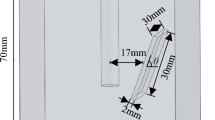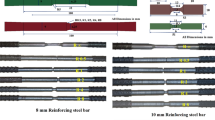Abstract
Rockfill material is widely used for construction of high rockfill dam, which undergoes significant particle breakage and three-dimensional stress path induced by the water pressure, earthquake, etc. The dilatancy equation, defined as the function of the dilatancy dg and the stress ratio η, is regarded as the foundation of elastoplastic constitutive model. Therefore, a dilatancy equation considering the influence of particle breakage and intermediate principal stress ratio b was proposed in this paper. A series of test data from rockfill materials including conventional triaxial test, constant-b test and plane strain test were used to verified the applicability of the equation. It was found that the proposed dilatancy equation considering two important factors (i.e., particle breakage and b-value) agree well with the rearranged test data of the rockfill material in terms of dg-η. While the other dilatancy equations showed significant poorer predictions when ignoring one or two of the factors. That is, the proposed dilatancy equation can well describe the dilatancy behavior of rockfill material when considering the combined influences of the particle breakage and b-value.
Similar content being viewed by others
References
Guo W. L. and Zhu J. G. (2017). “Particle breakage energy and stress dilatancy in drained shear of rockfills.” Geotechnique Letters, Vol. 7,No. 4, pp. 304–308, DOI: https://doi.org/10.1680/jgele.17.00099.
Rowe, P. W. (1962). “The stress-dilatancy relation for the static equilibrium of an assembly of particles in contact.” Proc. The Royal Society of London. Series A, Mathematical and Physical Sciences, Vol. 269,No. 1339, pp. 500–527.
Salim, W. and Indraratna, B. (2004). “A new elastoplastic constitutive model for coarse granular aggregates incorporating particle breakage.” Canadian Geotechnical Journal, Vol. 41,No. 4, pp. 657–671, DOI: https://doi.org/10.1139/t04-025.
Shi, W. C., Zhu, J. G., Zhao, Z. H., and Liu, H. L. (2010). “Strength and deformation behaviour of coarse-grained soil by true triaxial tests.” Journal of Central South University of Technology, Vol. 17,No. 5, pp. 1095–1102, DOI: https://doi.org/10.1007/s11771-010-0602-5.
Shi, W. C. (2008). “True triaxial tests on coarse-grained soils and study on constitutive model.” PhD Thesis, Hohai University, Nanjing, 2008 (in Chinese).
Sukkarak, R., Pramthawee, P., and Jongpradist, P. (2017). “A modified elasto-plastic model with double yield surfaces and considering particle breakage for the settlement analysis of high rockfill dams.” KSCE Journal of Civil Engineering, Vol. 21,No. 3, pp. 734–745, DOI: https://doi.org/10.1007/s12205-016-0867-9.
Tabibnejad, A., Heshmati, A., Salehzadeh, H., and Tabatabaei, S. H. (2015). “Effect of gradation curve and dry density on collapse deformation behavior of a rockfill material.” KSCE Journal of Civil Engineering, Vol. 19,No. 3, pp. 631–640, DOI: https://doi.org/10.1007/s12205-013-0682-5.
Ueng, T. S. and Chen, T. J. (2000). “Energy aspects of particle breakage in drained shear of sands.” Géotechnique, Vol. 50,No. 1, pp. 65–72, DOI: https://doi.org/10.1680/geot.2000.50.1.65.
Xiao, Y., Liu, H. L., Chen, Y., and Zhang, W. (2014). “Particle size effects in granular soils under true triaxial conditions.” Géotechnique, Vol. 64,No. 8, pp. 667–672, DOI: https://doi.org/10.1680/geot.14.T.002.
Xiao, Y., Liu, H. L., Desai, C. S., Sun, Y. F., and Liu, H. (2016). “Effect of intermediate principal-stress ratio on particle breakage of rockfill material.” Journal of Geotechnical and Geoenvironmental Engineering, Vol. 142, No. 4, p. 06015017, DOI: https://doi.org/10.1061/(ASCE)GT.1943-5606.0001433.
Xiao, Y., Liu, H. L., Zhu, J. G., and Shi, W. C. (2011). “Dilatancy equation of rockfill material under the true triaxial stress condition.” Science China: Technological Sciences, Vol. 54, No. s1, pp. 175–184, DOI: https://doi.org/10.1007/s11431-011-4636-1.
Zhuang, L., Nakata, Y., Kim, U. G., and Kim, D. (2014). “Influence of relative density, particle shape, and stress path on the plane strain compression behavior of granular materials.” Acta Geotechnica, Vol. 9,No. 2, pp. 241–255, DOI: https://doi.org/10.1007/s11440-013-0253-4.
Acknowledgements
The authors gratefully acknowledge the financial support from the National Key R&D Program of China (2017YFC0405102), China Postdoctoral Science Foundation (2018M640500), and research grant (GG201705) from Key Technologies R&D Program of Henan water conservancy.
Author information
Authors and Affiliations
Corresponding author
Rights and permissions
About this article
Cite this article
Guo, W., Chen, L. A Stress-Dilatancy Relationship for Rockfill Incorporating Particle Breakage and Intermediate Principal-Stress Ratio. KSCE J Civ Eng 23, 2847–2851 (2019). https://doi.org/10.1007/s12205-019-0279-8
Received:
Accepted:
Published:
Issue Date:
DOI: https://doi.org/10.1007/s12205-019-0279-8




